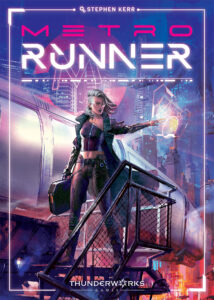 Regular BGQ readers probably know of my love of the Cyberpunk theme. If you drop a game on the table in this genre I’ll play it. Recently I’ve covered Cyberpunk Red: Combat Zone, the upcoming Cyberpunk 2077: The Board Game, and Tamashii: Chronicle of Ascend. All were enjoyable and still regularly make their way to my table (well maybe not the prototype copy of Cyberpunk 2077 as that’s just a basic preview copy). But regardless. I have a soft spot for games related to this theme.
Regular BGQ readers probably know of my love of the Cyberpunk theme. If you drop a game on the table in this genre I’ll play it. Recently I’ve covered Cyberpunk Red: Combat Zone, the upcoming Cyberpunk 2077: The Board Game, and Tamashii: Chronicle of Ascend. All were enjoyable and still regularly make their way to my table (well maybe not the prototype copy of Cyberpunk 2077 as that’s just a basic preview copy). But regardless. I have a soft spot for games related to this theme.
Fresh off its debut at Gen Con 2024, I’ve gotten to dive into Metrortunner from Thunderworks Games (Cartographers, Roll Player Adventures). Set on the metro line of Mirror City, you are a hacker trying to make a name for yourself. As you circle the districts, you’ll hack, complete jobs, and try to increase your street cred in the form of notoriety and influence.
Gameplay Overview:
In Metrorunner, turns (for the most part) are pretty snappy. Each player first moves their runner 1-2 spaces along the metro track. Then they can either take the action of the space they stopped on or take the district action.
Location spots will either allow you to acquire more job cards, collect resource cubes, or attempt a hack. District actions will allow you to collect the resource cubes sitting in the distract or complete a job (matching the district color).
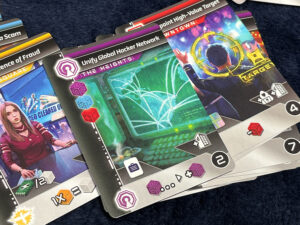
To complete a job you need to turn in the matching resource cubes. Afterward, the job earns you some immediate bonuses (notoriety, cubes, cash, or influence) and many times an ongoing bonus. These are usually in the form of benefits regarding resource cubes (pay fewer for jobs, use a color as wild, or gain bonus cubes when you collect some). Completed jobs will also earn you victory points at the end of the game.
Outside of working on jobs, you can also attempt to hack the network. In the center of the board are 9 PANOP tiles. When you hack, you are trying to create a path from one specific side of the board to another (based on one of the two faceup hacking cards). You are allowed 2 manipulations of the PANOP tiles. These let you rotate, shift, or swap tiles in an attempt to create a path. As you level up your influence track, you’ll gain access to bonus areas of the hacking card that allow grant you rewards for making extra connections. A successful hack will grant you rewards in the form of notoriety, cubes, or cash).
So I haven’t talked yet about what cash does. There are four boost actions available to a player on their turn. They can spend 1-2 cash tokens to use a boost, which breaks the game in some way. For example, for $1, you can take a car service to move anywhere on the board. For $2, you can take a second action on your turn. Boosts are expensive but pretty powerful.
The game ends once either someone has completed 9 jobs, or someone has reached the 10th space on the influence or notoriety track.
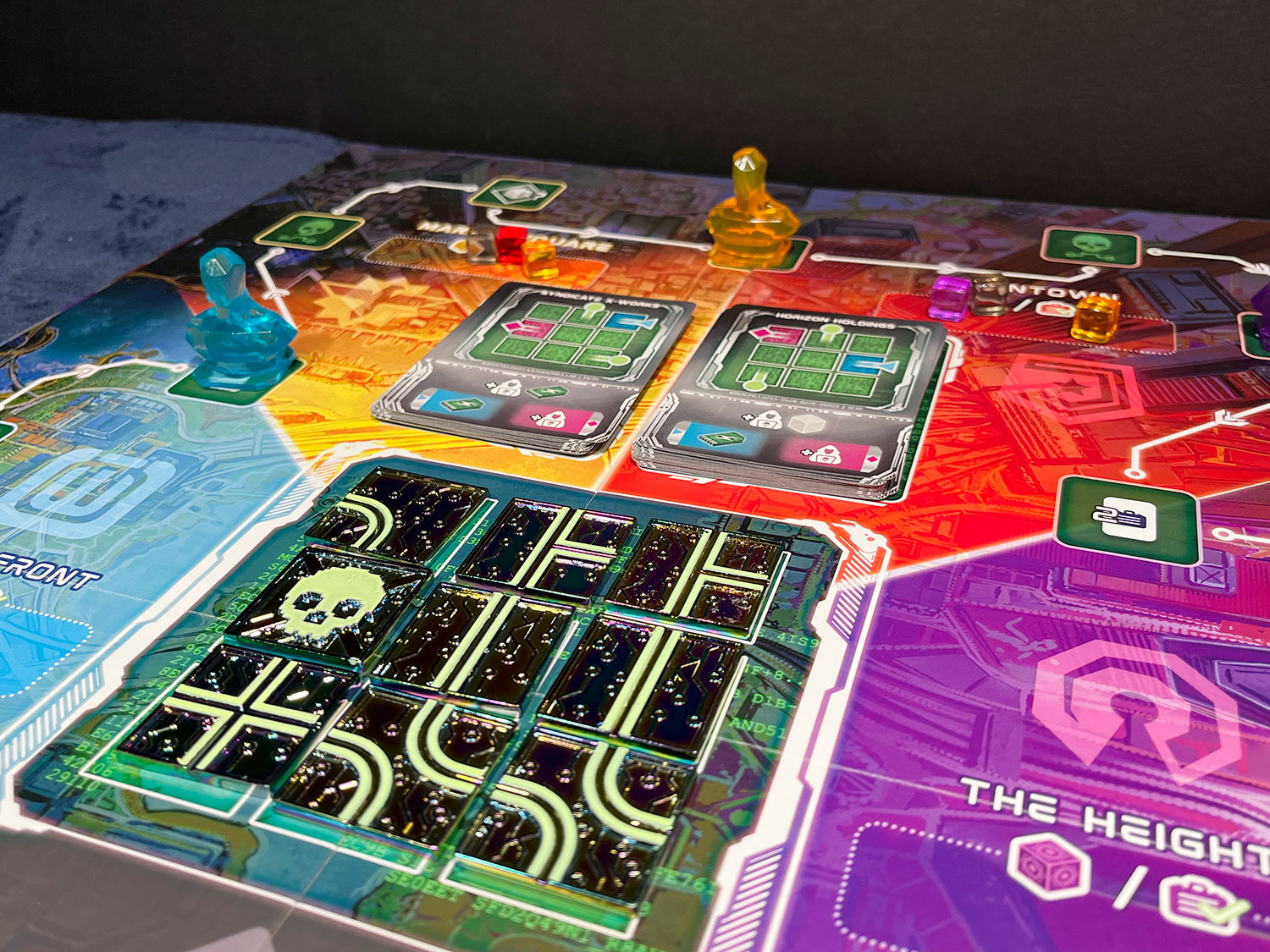
Game Experience:
At its heart, Metrorunner is a rondel game. You are moving around the circle (skipping over occupied spaces) and taking the action of the space you end on. At first, we were a little put off by the lack of player aids saying what each of the spaces does. But in practice, it only took about a round or two to figure them out. You either collect cubes, draw jobs, or attempt a hack. Easy peasy.
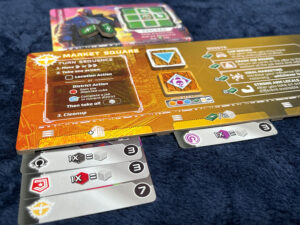
When Metrorunner is at its best, it has snappy turns with minimal downtime. Move your runner, collect cubes, and eventually complete a job. Jobs give you bonuses, which let you build up a little bit of an engine over time. So I complete the job that lets me pay one less orange cube on future jobs. Then I complete my next one which allows me to gain an extra red cube whenever I gain a red cube. These little bits add up to help you complete bigger and better jobs in the future. It’s this part of Metrorunner that I really enjoyed.
Where it falls apart for me is with the Hacking game. At face value, it looks fun. I actually enjoy these types of spatial puzzles. Figuring out the optimal way to get from point A to point B using only a couple of moves? Sign me up. The problem is that that game grinds to a halt anytime someone starts a hack. You can kind of try to plan ahead of time, but if someone else hacks before you, the cards and tile locations will all be different.
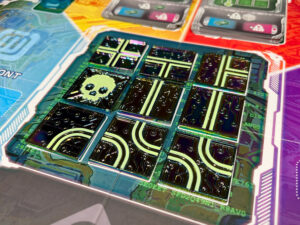
So before someone goes, they first check to see if they can do a hack. With only 2 moves, you have to be careful about hacking and not finishing it, otherwise you’ve wasted a turn. While you can spend cubes or cards to get extra moves, it’s rarely useful to do it (the one exception maybe being to spend 1 cube) as the rewards just aren’t cost-effective to do that. It got to the point in our games where we’d all help other players hack just to make it go quicker (and to give you something to do while they were doing it). I think I’d prefer to have each player have their own hacking tiles. While there would be less player interaction, you could at least plan ahead or work on it over multiple turns.
Moving on from hacking, I did like the boost actions. Gaining money is not something you are going to do often, so you’ll need to be careful of how you spend your dollars. Being able to move anywhere on the board, take an extra action, increase one of your tracks, or reset the job market can all be powerful boosts when used at the right time. I think we used the car service boost the most, allowing us to skip the rondel requirements and just move where we needed to go. While it’s gamebreakingly powerful, it’s not something you can do every turn.
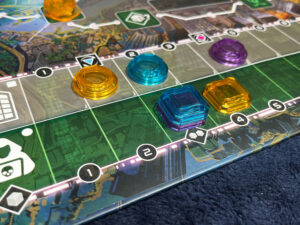
As part of the review copy, Thunderworks Games provided the Dropsite mini-expansion. After our first game, I included the expansion to see what it added. Overall I liked it and used it in every future game. It’s easy to include and adds a bit of pick-up and deliver to the game. When you land on a Dropsite card, you collect it and then you ‘re tasked with taking it to its delivery spot. The more cards you have completed at the end of the game, the more you score. It’s just an extra way to grab a few points and gives you reasons to stop in other spaces on the board. A solid addition with low rules overhead.
Finally, I want to touch on the theme of the game. As I said at the start, I’m a huge Cyberpunk fan. While the art from Ignacio Bazán Lazcano here is top-notch, the theme really only goes skin deep. Each character has a back story, but their unique powers only give them a special hacking manipulation power (none of which are all that exciting). So, really, you are spending generic cubes to complete jobs. The rulebook never even says what the cubes represent. While the job cards have fun, thematic names, overall the theme here is pretty pasted on.
Final Thoughts:
I think Metrorunner is a good game, but it’s not as great as it could be. When the players are taking quick, snappy turns, the game shines. When someone goes to hack, the game slams on the brakes so bad you almost get whiplash. It just feels at odds with the rest of the gameplay. I think that’s also why the game is best at 2 players. There are fewer people to mess with the hacking grid, but you still get some competition. I did try the solo game, and it was actually pretty solid. The AI runner can give you a bit of a challenge, so if you are a solo player, you may enjoy this mode. However, the other thing to be aware of is that Metrorunner isn’t very different from game to game. The main thing that changes is your runner’s power, but as powers are kind of weak, this won’t help the game feel all that different.
Final Score: 3 Stars – When the turns are quick, the game is great. When someone stops to hack, things grind to a halt.
 Hits:
Hits:
• Great visuals
• Quick snappy turns (usually)
• A little bit of engine building added in
Misses:
• Hacking feels at odds with the rest of the game
• Theme is pasted on
• Not much variety from game to game
Source: Board Game Quest



